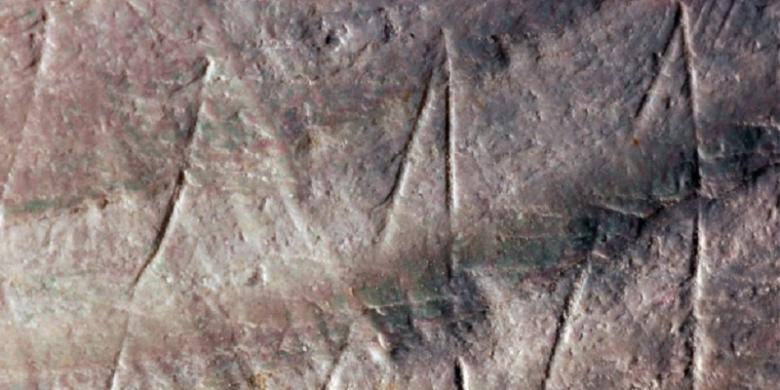Jakarta (DreamLandLibrary) - The days are getting stronger, that the beginning of civilization came from the archipelago.
Original Title: Cave Painting in Sulawesi, the Oldest in the World
The hand-painted stencil found in the Maros cave, Sulawesi, is estimated to be 40,000 years old. "Nature" magazine reports on research by a team of experts from Australia and Indonesia.
During this time, hand and animal stencils on the walls of the cave that are considered the oldest are in Europe, namely in the cave of El Castillo in northern Spain, which is estimated to be 37,300 years old.
But according to the latest research, hand stencil paintings on the walls of the Maros cave in South Sulawesi are still older. The ancient inhabitants allegedly painted the hand drawing about 40,000 years ago. Thus the results of the research were conducted by a team of experts from Australia and Indonesia.
The expert team led by Anthony Dosseto from the University of Wollongong, Australia, examined seven caves in Sulawesi with 12 paintings, namely hand stencils drawn in red and drawings of babirusa animals.
These paintings have actually been discovered more than 50 years ago. But detailed research has never been done to determine its age. Previous experts thought that such paintings made in tropical climates would not last more than 10,000 years.
A new view of human evolution
The research team from Australia and Indonesia then conducted a repeat study. The latest research results in the Maros cave of Sulawesi can change the view of the history of the spread and human civilization.
The hand-painted stencil is estimated to be at least 40,000 years old, while the babirusa painting is probably more than 35,000 years old. The expert team said, this is one of the oldest animal paintings, "if not the oldest" in the world ever found.
"With this it can be proven, that humans around 40,000 years ago spread in various directions," said Anthony Dosseto. "Europe can no longer claim that they were the first to be able to develop abstract paintings."
The determination of the age of the paintings in the cave was carried out by the uranium measurement method. The calculation is based on the decay of radioactive elements. With this method, a minimum age for a painting can be determined. That means the paintings might be older.
Important discovery
Original Title: Cave Painting in Sulawesi, the Oldest in the World
The hand-painted stencil found in the Maros cave, Sulawesi, is estimated to be 40,000 years old. "Nature" magazine reports on research by a team of experts from Australia and Indonesia.
During this time, hand and animal stencils on the walls of the cave that are considered the oldest are in Europe, namely in the cave of El Castillo in northern Spain, which is estimated to be 37,300 years old.
But according to the latest research, hand stencil paintings on the walls of the Maros cave in South Sulawesi are still older. The ancient inhabitants allegedly painted the hand drawing about 40,000 years ago. Thus the results of the research were conducted by a team of experts from Australia and Indonesia.
The expert team led by Anthony Dosseto from the University of Wollongong, Australia, examined seven caves in Sulawesi with 12 paintings, namely hand stencils drawn in red and drawings of babirusa animals.
These paintings have actually been discovered more than 50 years ago. But detailed research has never been done to determine its age. Previous experts thought that such paintings made in tropical climates would not last more than 10,000 years.
A new view of human evolution
The research team from Australia and Indonesia then conducted a repeat study. The latest research results in the Maros cave of Sulawesi can change the view of the history of the spread and human civilization.
The hand-painted stencil is estimated to be at least 40,000 years old, while the babirusa painting is probably more than 35,000 years old. The expert team said, this is one of the oldest animal paintings, "if not the oldest" in the world ever found.
"With this it can be proven, that humans around 40,000 years ago spread in various directions," said Anthony Dosseto. "Europe can no longer claim that they were the first to be able to develop abstract paintings."
The determination of the age of the paintings in the cave was carried out by the uranium measurement method. The calculation is based on the decay of radioactive elements. With this method, a minimum age for a painting can be determined. That means the paintings might be older.
Important discovery
Research on the age of ancient paintings in caves is considered important, because the paintings are an indicator that the painter "has the ability to think abstractly," said Thomas Sutikna, a member of the research team from the University of Wollongong.
The results of this latest research again emphasize the important role of the Asian continent in the process of human evolution. Earlier in 2003, a spectacular discovery of homo floresiensis (Flores Man) was also carried out, also known as Hobbit because of his small body.
Source: http://www.dw.de/lukis-gua-di-sulawesi-tertua-di-dunia/a-17986287
Image Source: http://www.dw.de/image/0,,17984037_303,00.jpg
The results of this latest research again emphasize the important role of the Asian continent in the process of human evolution. Earlier in 2003, a spectacular discovery of homo floresiensis (Flores Man) was also carried out, also known as Hobbit because of his small body.
Source: http://www.dw.de/lukis-gua-di-sulawesi-tertua-di-dunia/a-17986287
Image Source: http://www.dw.de/image/0,,17984037_303,00.jpg













